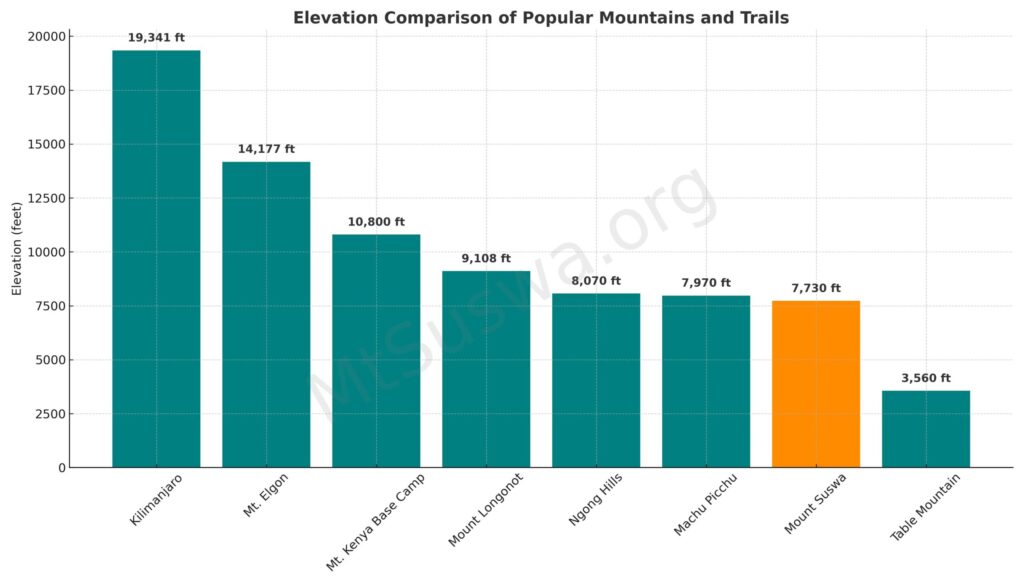Mount Suswa rises to an elevation of 2,356 meters (7,730 feet) above sea level, making it a significant but relatively moderate peak in the Kenyan Rift Valley.
🏔️ Mt. Suswa Elevation Facts
| Feature | Measurement |
|---|---|
| Summit Elevation | 2,356 m (7,730 ft) |
| Caldera Floor Elevation | ~2,000–2,100 m |
| Elevation Gain (Typical Hike) | 250–350 meters (820–1,150 feet) depending on the route |
| Trail Distance | Varies: 4–12+ km roundtrip depending on whether you hike the rim, summit, caves, or all |
🥾 Typical Hiking Elevation Gain
Most visitors drive up to the outer caldera rim via a rough 4×4 road, which significantly reduces the elevation gain. From there:
- Short hikes (e.g., to the lava caves or inner ring trench):
- Elevation gain: ~100–150 meters
- Easy to moderate effort
- Longer hikes (e.g., full caldera rim walk or summit ascent):
- Elevation gain: 250–350 meters, sometimes more if descending into the inner caldera
- Moderate to strenuous depending on fitness and route
If starting from the Suswa Conservancy gate (lowlands) on foot without a vehicle, the total climb can exceed 600 meters—a much more demanding trek.
🧭 Summary
Mount Suswa stands 2,356 m tall, but most hikers will climb between 250–350 m during a typical hike starting from the caldera rim access point. The total gain depends on your chosen route—rim walks, cave visits, and summit ascents all offer different challenges.
🏔️ Elevation Comparison: Mt. Suswa vs Other Hikes
| Mountain / Trail | Elevation (m) | Elevation (ft) | Notes |
|---|---|---|---|
| Mount Suswa | 2,356 m | 7,730 ft | Twin caldera, moderate elevation |
| Mount Longonot (Kenya) | 2,776 m | 9,108 ft | Steeper crater climb |
| Mount Kenya Base Camp | 3,300 m+ | 10,800 ft+ | Much higher—altitude effects start here |
| Ngong Hills (Kenya) | 2,460 m | 8,070 ft | Comparable to Suswa, more consistent ridgeline walking |
| Mount Kilimanjaro (Uhuru) | 5,895 m | 19,341 ft | Extremely high—acute mountain sickness likely |
| Mount Elgon (Kenya/Uganda) | 4,321 m | 14,177 ft | High elevation, cooler climate |
| Table Mountain (South Africa) | 1,085 m | 3,560 ft | Much lower than Suswa |
| Machu Picchu (Peru) | 2,430 m | 7,970 ft | Very similar elevation to Suswa |

🫁 How Mt. Suswa’s Elevation Affects the Body
At 2,356 meters, Mount Suswa sits in the “moderate altitude” zone:
| Altitude Zone | Range | Typical Effects |
|---|---|---|
| Sea Level | 0–500 m | No effect |
| Low Altitude | 500–1,500 m | Normal breathing, minimal changes |
| Moderate Altitude | 1,500–2,500 m | Slight increase in breathing rate, mild fatigue possible |
| High Altitude | 2,500–3,500 m | Risk of mild altitude symptoms starts |
| Very High/Extreme | >3,500 m | Acute Mountain Sickness (AMS) more likely |
🔹 At Mt. Suswa (2,356 m):
- Most people will not experience altitude sickness, especially if they’re coming from Nairobi (~1,795 m).
- You may notice:
- Heavier breathing during uphill climbs
- Slightly faster heart rate
- Mild fatigue earlier than usual if unacclimatized
- Hydration and pacing help minimize these effects
🧠 Practical Tips for Hiking at Mt. Suswa’s Elevation
- Pace yourself: Altitude may slightly reduce your endurance.
- Hydrate well: The air is drier, and dehydration can feel like altitude sickness.
- Warm layers: Early mornings and evenings can be chilly at this elevation.
- Snack regularly: Energy dips more quickly at altitude, even if it feels mild.
🧭 Summary
At 2,356 m, Mount Suswa is moderately high but very manageable for most hikers. It’s slightly higher than Nairobi, so most visitors are already partially acclimatized. Compared to higher Kenyan peaks like Mount Kenya or Mount Elgon, Suswa is more beginner-friendly and doesn’t pose serious altitude risks—but still delivers sweeping views and real adventure.
